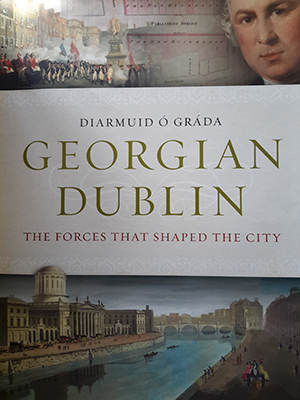Georgian Dublin: the forces that shaped the city
Published in Book Reviews, Issue 3 (May/June 2016), Reviews, Volume 24DIARMUID Ó GRÁDA
University College Cork Press
€39
ISBN 9781782051473
Reviewed by: Sylvie Kleinman

This book is a ‘gorgeous mask’ of sorts. Both front and back covers foretell that it will be (and is) abundantly and beautifully illustrated. They harmoniously convey that well-ingrained feel-good effect of eighteenth-century Dublin as an august Enlightenment metropolis; nothing offends. Wheatley’s Volunteers salute King Billy with order and restraint, while James Gandon gazes out at us purposefully from a corner. In a peaceful riverscape, his majestic Four Courts are reflected onto a remarkably unseaweedy, pristine and celestially blue Liffey. But flip this (very weighty) tome over: the imposing royal seal and elaborate dropcap on an official proclamation stand out, yet the fine print condemns the violence of weavers attempting to form combinations (precursors of trade unions), hinting that all is not as serene as in Malton’s idealised views. A very lovely (and we are forgiven for concluding very virtuous) creature, kitted out as a Roman huntress, turns out to be none other than the infamous procuress Mrs Leeson. The mask has now slipped, though we are still awed by Georgian Dublin, if indeed the ‘doyenne of her madams’ sat for Batoni, a leading portraitist of the Anglo-Irish élites while in Rome, in such a fine neo-classical allegory.
The cover projects what the book does not aim to be—a gentry-centred conventional history from within the elegant stuccoed drawing rooms of the élites in those grand red-brick squares, populated mainly by Protestants in this phase of the capital’s history. Ó Gráda explores problematic features of the city’s growth and outward expansion, which (it is claimed) have received so little attention—in public and popularised histories, that is. His approach is an urban planner’s, so the two lengthiest chapters discuss multiple facets of urbanisation, planning trends and growth patterns. Dublin became the second-largest city in the British Isles owing to its geography, and its roles as parliamentary, administrative, industrial and commercial centre combined with that of a major port. In clear prose, Ó Gráda discusses the interface between the authorities and administrators and the multiple challenges faced by ‘Georgian Dublin’. This he recognises as a ‘construct’, given that it lasted from 1714 to 1820, but specialist academics will take issue with his statement that this rigid time-frame is imposed by ‘historians’. They may have done so once but no longer, preferring now to examine change over time. Vital is the reminder to a general public of Ireland’s pre-Famine demographics, a major source of interconnected tensions and change. In a phenomenal rise, Dublin’s population nearly doubled in the seven decades from mid-century to the first official census of 1821, which recorded a figure of 227,335 (though for an expanded urban space). Other thematic and interlocking chapters look at deprivation, criminality, immorality and prostitution, but despite the abundant evocative quotes from contemporary sources (mainly the press) the narrative never trivialises nor descends into a ‘rakes-and-ruffians’ genre. Much empathy is displayed for the anonymous sick, homeless and labouring underbelly of the city. Academics will nonetheless identify topics already explored in innumerable scholarly studies—many, however, tucked away in journals rarely opened by the general public. A comprehensive bibliography confirms the author’s debt to such a corpus, which evidently includes the ground-breaking The gorgeous mask: Dublin 1700–1850 (1987), edited by David Dickson. Some will take issue with assertive or overarching conclusions, e.g. the scarcity of accounts on Orange Order violence.
As regards the teeming sex trade (on which Dublin, frequently cross-referenced with other European capitals, had no monopoly), the author remains sombre on this distressing theme. We are exposed to the noise and visibility of streetwalkers frequently offending passers-by in reports about their ‘wailing, screaming and shrieking’. Fifty-seven brothels are listed and mapped in an appendix that also highlights rape and empressment of girls as young as thirteen. That the bawdy or bath houses (most in the heart of the city) were linked to corruption, gambling, gangs and stolen goods explains why they were often the locus for serious disturbances and violence, sometimes involving thousands. Another appendix inventories 42 hanging shop signs—all of which, I noted, save the Munster King, look positively English.
Most of the book’s illustrations, many in colour, are high-quality and of a viewer-friendly size. Many are familiar to specialist researchers but are reproduced here for the first time. They are neither numbered nor listed, however, and a few are not adequately identified or properly referenced; authors are graciously thanked but the source publication is not identified. In some cases, in a not uncommon process, the image is not really deconstructed and thus tells an occasionally distorted story. An elderly beggar in a highly accomplished sketch appears remarkably clean in an immaculate coat; it is not at all evident that ‘rubbish pickers’ are sifting through dirty detritus, and one fails to detect the infamous dungheaps. Ó Gráda is not at fault, though, because artists produced sanitised views, airbrushing out of history the dirty, diseased or dispossessed. Even Petrie’s ‘Squatters in a disused church’ (opp. p. 283), which may have been a more realistic choice for the cover, does not graphically convey ‘pitiable, wretched or famished’ destitution. A stark photo of the servants’ entrance of a Merrion Square house illustrates ‘the social division expressed by architecture’. Batoni never left Rome and painted an Italian contessa as Diana, not our Mrs Leeson, who was no Venetian castle courtesan. Despite these reservations, let us hope that this glossy book does not remain unopened on coffee-tables.
Sylvie Kleinman is an eighteenth-century historian.


















